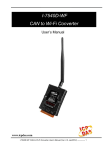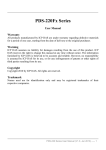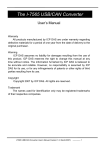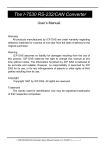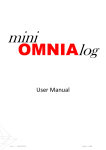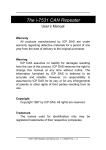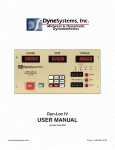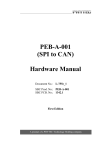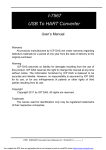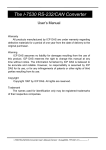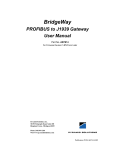Download GW-7228 J1939/Modbus RTU Slave Gateway
Transcript
GW-7228 J1939/Modbus RTU Slave Gateway User’s Manual www.icpdas.com GW-7228 J1939/Modbus RTU Slave Gateway User’s Manual (Ver 1.2, May/2011) ------------- 1 Warranty All products manufactured by ICP DAS are under warranty regarding defective materials for a period of one year from the date of delivery to the original purchaser. Warning ICP DAS assumes no liability for damages resulting from the use of this product. ICP DAS reserves the right to change this manual at any time without notice. The information furnished by ICP DAS is believed to be accurate and reliable. However, no responsibility is assumed by ICP DAS for its use, or for any infringements of patents or other rights of third parties resulting from its use. Copyright Copyright 2010 by ICP DAS. All rights are reserved. Trademark The names used for identification only may be registered trademarks of their respective companies. Document Revision Version 1.0 1.1 Author T.H. T.H. Date 2010-07-26 2011-04-29 1.2 T.H. 2011-05-16 Description of changes First Release Revision Modify Modbus register define Add Parameter Download Function GW-7228 J1939/Modbus RTU Slave Gateway User’s Manual (Ver 1.2, May/2011) ------------- 2 Table of Contents 1. Introduction .......................................................................................5 1.1 1.2 Mode of operation .............................................................................. 6 Features............................................................................................. 6 1.3 Specifications ..................................................................................... 6 2. Hardware ...........................................................................................8 2.1 2.2 Block Diagram.................................................................................... 8 Pin Assignment .................................................................................. 9 2.3 Hardware Connection ...................................................................... 10 CAN port connection ...................................................................... 10 Serial port connection......................................................................11 Terminator Resistor Settings ............................................................ 12 2.3.1 2.3.2 2.4 2.5 2.6 2.6.1 2.6.2 2.7 2.8 Watchdog Timer Settings ................................................................. 13 Init / Normal Dip-switch .................................................................... 13 Firmware Update Mode.................................................................. 13 Firmware Operation Mode.............................................................. 16 LED Indication.................................................................................. 17 Cable Selection................................................................................ 18 3. Software...........................................................................................20 3.1 3.2 3.2.1 Configuration Tool – GW-7228 Utility ............................................... 20 GW-7228 Utility ................................................................................ 21 Connection Screen......................................................................... 21 3.2.2 Main Screen ................................................................................... 23 4. Communication Network ................................................................30 4.1 4.2.1 Modbus Network .............................................................................. 30 Supported Modbus Functions ........................................................ 30 Modbus Address ............................................................................ 30 J1939 Network ................................................................................. 32 Communication Methods................................................................ 32 4.2.2 4.2.3 4.2.4 Parameter Groups.......................................................................... 32 Suspect Parameter Number (SPN) ................................................ 33 J1939 Message Transmission........................................................ 34 4.2.5 4.2.6 J1939 Receiving Messages ........................................................... 35 Transport Protocol for Large Messages ......................................... 35 4.1.1 4.1.2 4.2 5. Application ......................................................................................36 5.1 Hardware Installation ....................................................................... 36 5.2 GW-7228 Utility Configuration.......................................................... 40 Modbus Network Configuration ...................................................... 40 5.2.1 GW-7228 J1939/Modbus RTU Slave Gateway User’s Manual (Ver 1.2, May/2011) ------------- 3 5.2.2 5.2.3 5.2.4 5.3 J1939 Network Configuration ......................................................... 40 J1939 I/O Configuration ................................................................. 41 Upload Parameter to the GW-7228 ................................................ 43 Modbus Communication .................................................................. 44 6. Troubleshooting..............................................................................47 GW-7228 J1939/Modbus RTU Slave Gateway User’s Manual (Ver 1.2, May/2011) ------------- 4 1. Introduction The GW-7228 is a solution that provides a protocol conversion between J1939 and Modbus RTU. For J1939 network, the GW-7228 supports PDU1, PDU2, broadcast and the destination specific type of J1939 messages. From the view of Modbus RTU network, the GW-7228 is a Modbus RTU slave to reply the request from Modbus RTU master. We provide Utility software for users to configure the parameters of J1939 / Modbus RTU of the GW-7228. The application fields can be Diesel powertrain applications, In-Vehicle networks for trucks and buses, etc. The following is the application architecture for the GW-7228 : Figure 1-1: Application of the GW-7228 GW-7228 J1939/Modbus RTU Slave Gateway User’s Manual (Ver 1.2, May/2011) ------------- 5 1.1 Mode of operation The GW-7228 provides centralized data storage, for data that is shared between the Modbus and J1939 networks. Data is placed into the GW-7228 by one network interface, and allowing the data to be read or written through the other network interface. 1.2 • • • • • • • • • • • • • • Features RoHS Design Provide PWR / J1939 / MODBUS indication LEDs The built-in jumper to select 120 ohm terminal resister of CAN bus Watchdog inside Transmission and reception of all types of J1939 messages, including PDU1, PDU2, broadcast and destination specific. J1939 Transport Protocol for transmission and reception of large messages (9 - 1785 bytes). Support BAM of Connection Management Message. Network addresses management. Support RS-232, RS-485 and RS-422 interfaces Support Modbus RTU slave protocol. Configurable for Modbus Network ID(1~250). Configurable baud rates of 2400, 4800, 9600, 19200, 38400, 57600, 115200 bps. Configurable for none, odd, or even parity and 1 or 2 stop bits. Support Function Code 03 / 04 / 06 / 16 of Modbus functions for reading and writing J1939 Messages. 1.3 Specifications [ UART specs: ] • Connector : 14-pin screw terminal connector • COM1 : RS-232(TXD, RXD, GND) RS-422(Tx+, Tx-, Rx+, Rx-) RS-485(D+, D-) • Baud Rate (bps) : 2400, 4800, 9600, 19200, 38400, 57600, 115200 GW-7228 J1939/Modbus RTU Slave Gateway User’s Manual (Ver 1.2, May/2011) ------------- 6 [ CAN specs: ] • CAN interface connector : 9-pin D-sub male • CAN Baud Rate : 250k • Isolation Voltage : 3000 VDC power protection on CAN side, 2500Vrms photo-couple isolation on CAN bus • Terminator Resistor: Selectable 120Ω terminator resistor by jumper • Specification; ISO-11898-2, CAN 2.0A and CAN 2.0B [ Module specs: ] • Dimensions : 117mm x 72mm x 35mm (H x W x D) • Operating temperature : -25 to 75ºC (-13 to 167ºF) • Storage temperature : -40 to 80ºC (-40 to 176ºF) • Humidity : 5 to 95%, non-condensing • LEDs : PWR LED for power J1939 LED for J1939 communication MODBUS LED for Modbus communication [ Software Utility Tool: ] • Provide Modbus network configuration interface. • Provide J1939 network configuration interface – Network Address / Device Name, etc. • Provide J1939 Input / Output configuration interface. [ Application: ] • Diesel power-train applications • In-Vehicle networks for trucks and buses • Truck-Trailer connections • Fleet management systems • On Board Diagnostics • Vehicle Automation GW-7228 J1939/Modbus RTU Slave Gateway User’s Manual (Ver 1.2, May/2011) ------------- 7 2. Hardware Figure 2-1: Hardware externals of the GW-7228 2.1 Block Diagram Figure 2-2 is a block diagram illustrating the functions on the GW7228 module. It provides the 3000Vrms Isolation in the CAN interface site. Figure 2-2: Block diagram of the GW-7228 GW-7228 J1939/Modbus RTU Slave Gateway User’s Manual (Ver 1.2, May/2011) ------------- 8 2.2 Pin Assignment Table 2-1: CAN DB9 Male Connector Pin Description 1 Not Connect 2 CAN Low 3 CAN Ground 4 Not Connect 5 6 CAN Ground 7 CAN High 8 Not Connect 9 Table 2-2: 14-pin screw terminal connecter Pin Description 1 RS-485 DATA+ 2 RS-485 DATA3 Not Connect 4 RS-422 Tx+ 5 RS-422 Tx6 RS-422 Rx+ 7 RS-422 Rx8 Not Connect 9 RS-232 RXD 10 RS-232 TXD 11 RS-232 GND 12 Not Connect 13 +Vs(+10 ~ +30 VDC) 14 GND GW-7228 J1939/Modbus RTU Slave Gateway User’s Manual (Ver 1.2, May/2011) ------------- 9 Figure 2-3: Pin Assignment on the GW-7228 2.3 Hardware Connection The GW-7228 module supports J1939 / Serial Port communication, it offers one CAN interface for J1939 network and three serial interfaces for Modbus network. 2.3.1 CAN port connection The pin assignment of the CAN port on the GW-7228 (DB9 male) is defined in both the CANopen DS102 profile and in appendix C of the DeviceNet specifications. It is the standard pin assignment for CAN. The hardware connection between device and the GW-7228 is as Figure 2-4. Figure 2-4: CAN Hardware Wire Connection GW-7228 J1939/Modbus RTU Slave Gateway User’s Manual (Ver 1.2, May/2011) ------------- 10 2.3.2 Serial port connection Connect the PC running GW-7228 Utility to the GW-7228 module by using a standard serial cable between the PC serial port and the screw terminal connector on the module. The GW-7228 offers three serial interfaces to the user, and not through any setting. It is recommended to use only one serial port (RS232, RS422 or RS485) of the gateway at the same time. The following figures describe the three COM port types to a serial device via serial network. Figure 2-5: RS-232 Wire Connection Figure 2-6: RS-422 Wire Connection Figure 2-7: RS-485 Wire Connection GW-7228 J1939/Modbus RTU Slave Gateway User’s Manual (Ver 1.2, May/2011) ------------- 11 2.4 Terminator Resistor Settings According to the ISO 11898 specifications, the CAN Bus network must be terminated by two terminal resistors (120Ω) for proper operation, as shown in the below figure. Figure 2-8: Terminal Resistor Therefore, the GW-7228 module supplies a jumper for users to active the terminal resistor or not. If users want to use this terminal resistor, please open the GW-7228 cover and use the JP3 to activate the 120Ω terminal resistor built in the module, as the Figure 2-9. Note that the default setting is active. Figure 2-9: Terminal Resistor Jumper GW-7228 J1939/Modbus RTU Slave Gateway User’s Manual (Ver 1.2, May/2011) ------------- 12 Enable (default) Disable Figure 2-10: Terminal resistor JP3 Jumper Position 2.5 Watchdog Timer Settings A watchdog timer (WDT) is a device that performs a specific operation after a certain period of time if something goes wrong and the system does not recover on its own. A watchdog timer can perform a warm boot(restarting the system) after a certain number of milliseconds. The GW-7228 module supplies a jumper for users to active the watchdog timer or not. If users want to use this WDT, can open the GW7228 cover and use the JP1 to activate the WDT built in the module, as the Figure 2-9. Note that the default setting is active. Enable (default) Disable Figure 2-11: Watchdog timer JP1 Jumper Position 2.6 Init / Normal Dip-switch On the back of the GW-7228 module, there is a dip-switch used for firmware operation or firmware updating of the module. The following steps show how to use this dip-switch. 2.6.1 Firmware Update Mode Please set the dip-switch to the “Init” (Initial) position as Figure 2-12, and then the GW-7228 will work in the “Firmware Update Mode” after GW-7228 J1939/Modbus RTU Slave Gateway User’s Manual (Ver 1.2, May/2011) ------------- 13 reset the power of the module. In this mode, users can update the firmware of the GW-7228 module from computer’s RS-232 port via CA0910 cable shown as Figure 2-14. Figure 2-12: Init Position of Dip-Switch Figure 2-13: CA-0910 Cable Figure 2-14: Firmware downloads connection GW-7228 J1939/Modbus RTU Slave Gateway User’s Manual (Ver 1.2, May/2011) ------------- 14 Users just need to execute “Firmware_Update_Tool.exe” and follow the below steps to complete the firmware updating process. [1] Choose “COM” interface and “COM Port”. [2] Click “Browser” button to choose firmware file. (e.g. GW7228.fw) [3] Click “Firmware Update” button to start firmware updating process. The result will show in “Firmware Update” field. 1 2 3 6 4 5 Figure 2-15: GW-7228 firmware update process The GW-7228 firmware can be downloaded from http://ftp.icpdas.com/pub/cd/fieldbus_cd/J1939/gateway/gw7228/firmware. The Firmware_Update_Tool program can be downloaded from http://ftp.icpdas.com/pub/cd/fieldbus_cd/J1939/gateway/gw7228/software/tool. GW-7228 J1939/Modbus RTU Slave Gateway User’s Manual (Ver 1.2, May/2011) ------------- 15 2.6.2 Firmware Operation Mode In the operation mode, users need to set the dip-switch to the “Normal” position as Figure 2-16 and reset the power. The GW-7228 can run in the operation mode. In this mode, users can use the Modbus Master command to set / get J1939 messages via COM port. Figure 2-16: Normal Position of Dip-Switch GW-7228 J1939/Modbus RTU Slave Gateway User’s Manual (Ver 1.2, May/2011) ------------- 16 2.7 LED Indication There are three LEDs to indicate what state the GW-7228 is in. The following is the illustration of these three LEDs and the position of these three LEDs shown as Figure 2-17. (1) PWR LED : It is used to help users to check whether the GW-7228 is standby. If the module is working in “firmware operation” mode, the PWR LED is always turned on. It is also used for demonstrating an error that has occurred. The PWR LED is normally turned on when the module works in a good condition. When the Bus-Off error is happened, the PWR LED will blink per 500 ms until the Bus-Off condition disappears. If the CAN message can’t be sent out successfully, then the PWR LED will blink per 100 ms. (2) J1939 LED : It is used to show whether the GW-7228 is transmitting/receiving CAN messages. The J1939 LED will blink whenever a CAN message is sending or receiving. (3) MODBUS LED : It is used to show whether the GW-7228 is transmitting/receiving Modbus messages. The MODBUS LED will blink whenever a Modbus message is sending or receiving. Figure 2-17: LED position of the GW-7228 GW-7228 J1939/Modbus RTU Slave Gateway User’s Manual (Ver 1.2, May/2011) ------------- 17 Table 2-3: LED indication of the GW-7228 LED Name GW-7228 Status LED Status Firmware Updating Mode ALL LEDs Hardware WDT Fail Contact to ICP DAS All LED always turned on No Error CAN Bus Transmission Fail CAN Bus-Off PWR LED Can’t Claim Address in J1939 Network Power Failure Transmission J1939 LED Bus Idle MODBUS Transmission LED Bus Idle Always turned on Blink per 100 ms Blink per 500 ms Blink per 1000 ms 2.8 All LED blink per 1 second All LED blink per 100 ms Off Blink Off Blink Off Cable Selection The CAN bus is a balanced (differential) 2-wire interface running over either a Shielded Twisted Pair (STP), Un-shielded Twisted Pair (UTP), or Ribbon cable. The CAN-L and CAN-H Wire start on one end of the total CAN network that a terminator of 120 Ohm is connected between CAN-L and CAN-H. The cable is connected from CAN node to CAN node, normally without or with short T connections. On the other end of the cable again a 120Ω(Ohm) terminator resistor is connected between the CAN lines. How to decide a cable type, cable length, and terminator depends on the baud rate in the CAN bus network, please refer to the following table 2-4. Figure 2-18: Un-shielded Twisted Pair (UTP) GW-7228 J1939/Modbus RTU Slave Gateway User’s Manual (Ver 1.2, May/2011) ------------- 18 Table 2-4: Cable selection Bus speed 50k bit/s at 1000m 100k bit/s at 500m 500k bit/s at 100m 1000k bit/s at 40m Cable type 0.75~0.8mm2 18AWG 0.5~0.6 mm2 20AWG 0.34~0.6mm2 22AWG, 20AWG 0.25~0.34mm2 23AWG, 22AWG Cable Terminator Bus Length Resistance/m 150~300 70 mOhm 600~1000m Ohm 150~300 < 60 mOhm 300~600m Ohm < 40 mOhm 127 Ohm 40~300m < 40 mOhm 124 Ohm 0~40m Note: The AWG means a standard method used to measure wire. The numbering system works backwards from what people would think, the thicker (heavier) the wire, the lower the number. For example: a 24AWG wire is thicker/heavier than a 26AWG wire. GW-7228 J1939/Modbus RTU Slave Gateway User’s Manual (Ver 1.2, May/2011) ------------- 19 3. Software This chapter describes how the GW-7228 J1939/Modbus RTU Interface is configured using the configuration tool (GW-7228 Utility). 3.1 Configuration Tool – GW-7228 Utility The GW-7228 configuration tool allows you to configure the parameters associated with the Modbus and J1939 network interfaces as well as to layout of the I/O table and set up the contents. GW-7228 Utility is a Microsoft Windows application that communicates with a GW-7228 over a standard RS-232/ RS-422/ RS485 serial link by using the PC serial port. It is compatible with Microsoft Windows 95, 98, NT, 2000, Vista and 7. The GW-7228 Utility can be downloaded from http://ftp.icpdas.com/pub/cd/fieldbus_cd/J1939/gateway/gw7228/software/utility. GW-7228 J1939/Modbus RTU Slave Gateway User’s Manual (Ver 1.2, May/2011) ------------- 20 3.2 GW-7228 Utility The following is the main screens provided by GW-7228 Utility. 3.2.1 Connection Screen When users execute the GW-7228 Utility, it will show connection function screen first for connecting to the GW-7228 as Figure 3-1. The following is the illustration for connection parameters. [1] COM [2] Baud Rate [3] Parity [4] Net ID [5] Data Bits [6] Stop Bits : The serial com port number. (COM1~ COM32) : Serial com port baud rate setting. (2400~115200 bps, default:115200) : Serial com port parity setting. (NONE / ODD / EVEN, default:NONE) : Modbus network Net ID setting. (1~250, default:1) : Serial com port data bits setting. (Fixed at 8) : Serial com port stop bits setting. (1 / 2, default:1) Figure 3-1: Connection Screen of GW-7228 Utility After finish the connection setting, please click “Connect” button to connect to the GW-7228 module. GW-7228 J1939/Modbus RTU Slave Gateway User’s Manual (Ver 1.2, May/2011) ------------- 21 If the connection settings, external wiring and the GW-7228 module are normal, it shows connection successful screen as Figure 3-4. The GW-7228 status such as Interface/Data Created/Error/Firmware Version would be shown, otherwise, it shows abnormal connection screen as Figure 3-2 and Figure 3-3. Figure 3-2: Open COM Error Screen Figure 3-3: COM Receive Time Out Error Screen Figure 3-4: COM Connection Successful Screen Table 3-1 GW-7228 error status Error Code Status 00 No Error 01 Can’t Claim Address in J1939 Network 02 CAN Bus-Off 04 CAN Bus Transmission Fail GW-7228 J1939/Modbus RTU Slave Gateway User’s Manual (Ver 1.2, May/2011) ------------- 22 3.2.2 Main Screen Figure 3-5: GW-7228 Utility Main Screen Display Areas: [1] GW-7228 Status : Display the module type and status information about the GW-7228 module that was detected. [2] Modbus : Configuration of Modbus network parameters. [3] J1939 : Configuration of J1939 network parameters. [4] J1939 I/O table : Configuration of the contents and layout of the I/O tables. GW-7228 J1939/Modbus RTU Slave Gateway User’s Manual (Ver 1.2, May/2011) ------------- 23 Menus and Tool Bar: [1] Load Configuration : Load a previously saved the GW-7228 configuration file. [2] Save Configuration : Save the current GW-7228 configuration to a file. [3] Download Parameter: Download the configuration from the GW7228 module and shown on the Utility’s interface. [4] Upload Parameter : Upload the configuration shown on the Utility’s interface to the GW-7228 module. [5] Connect to GW-7228 : Establish a connection with the GW-7228. [6] Device Name : The J1939 NAME to be used by the module in address claim messages. [7] About : Display the GW-7228 utility version. Modbus Configuration The Modbus configuration contains the parameters used to control the behavior of the Modbus serial interface. The parameters are described as Table 3-2. All modules on the network must use the same baud/parity/data/stop bits configuration. Table 3-2 Modbus Configuration Parameters Item Description Range The ID of the module on the Modbus Net ID network. All modules on the network must 1~250 have a unique address. Baud Rate The network baud rate. 2400~115200 The serial communication parity. NONE / ODD Parity / EVEN The number of data bits used in the serial Fixed at 8 Data Bits communication. The number of stop bits used in the serial 1 / 2 Stop Bits communication. GW-7228 J1939/Modbus RTU Slave Gateway User’s Manual (Ver 1.2, May/2011) ------------- 24 J1939 Configuration The J1939 network configuration parameters are described in Table 3-3 below. Table 3-3 J1939 Configuration Parameters Item Description Range Network It shows the current location of J1939 0~254 Address network. To be used by the module in address claim Please see Device messages, each J1939 module should have the NAME a unique NAME. J1939-81 specification Auto CAN When Can Bus-off, the module will auto Enable Bus-Off reset the CAN controller. Disable Reset PDU1 Check Enable/Disable to check the destination Enable Destination address in PDU1 mode. Disable Address If this option is enabled, data in the I/O table Swap IO would be byte swapped on 16-bit Enable Byte boundaries; this function is easy reading the Disable J1939 data on Modbus network. Enable or Disable auto transmission J1939 Auto Enable output message without to control the Transmission Disable Modbus register 42009 (Dec). Network This is the list of possible addresses, the Address module only claims a single address at a 0~253 Configuration time. Up to 20 addresses may be in this list. GW-7228 J1939/Modbus RTU Slave Gateway User’s Manual (Ver 1.2, May/2011) ------------- 25 J1939 Device Name Figure 3-6: J1939 Device Name Screen The J1939 NAME is a 64-bit value that must be unique for every module on J1939 network. NAME are composed of fields as shown in Table 3-4 Table 3-4 J1939 NAME Fields Arbitrary Vehicle Industry Address Vehicle System Group Capable 1 bit Reserved Function ECU Manufacturer Identity Instance Instance Code Number 5 bit 3 bit 11 bit 21 bit Function System Instance 3 bit Byte 8 4 bit 7 bit 1 bit Byte 7 8 bit Byte 6 Byte Byte Byte Byte 4 3 2 1 Byte 5 J1939 Input/Output Table The J1939 Input/Output table is used define the content and format of the J1939 messages. The Data from J1939 messages that are to be transmitted are mapped to the locations in the input or output table GW-7228 J1939/Modbus RTU Slave Gateway User’s Manual (Ver 1.2, May/2011) ------------- 26 respectively. Input Table The Input table holds data that is collected from the J1939 network and can be read by the Modbus master. Input data points are associated with data from messages that are received on the J1939 network. Output Table The Output table holds data that is written by the Modbus master and will be transmitted on the J1939 network. Output data points are associated with data of messages that will be transmitted on the J1939 network. Figure 3-7: J1939 Input/Output Configuration Table GW-7228 J1939/Modbus RTU Slave Gateway User’s Manual (Ver 1.2, May/2011) ------------- 27 Table 3-5 J1939 Input/Output Configuration Parameter Item Description The offset setting into the Modbus I/O Register data, the offset is in bytes. In the Input Table, the offset is into the Modbus AI Input table. Register Offset Input Register Offset Modbus Input Register (Byte) (Word) 0,1 30001(LSB/MSB) 2,3 … 30002(LSB/MSB) … 3070, 3071 31536(LSB/MSB) Range 0~1535 (byte) In the Output Table, the offset is into the Modbus AI Output table. Modbus Output Data Length PGN Priority Output Register Offset Register (Byte) (Word) 0,1 40001(LSB/MSB) 2,3 … 3070, 3071 40002(LSB/MSB) … 41536(LSB/MSB) The amount of the data to be transferred between the Modbus I/O table and the J1939 message data, the length is in bytes. The J1939 PGN is associated with this data field. In Input Table, the data from messages received with this PGN will be transferred into the Input table. In Output Table, a message with this PGN will be built and transmitted using data from the Output table. The data is used to optimize message latency 0~1785 (byte) Any kinds of J1939 Parameter Group Number 0~7 GW-7228 J1939/Modbus RTU Slave Gateway User’s Manual (Ver 1.2, May/2011) ------------- 28 for transmission onto the bus only; the priority of any message can be set from highest, 0, to lowest, 7. In the output table, which refers to the Destination Address, this data defines the specific address to which the message is being sent. If the Destination Address is set to 255, the message will be broadcast. Address Update Rate Message Offset In the input table, which refers to the Source Address, It shall only be one device on the network with a given source address, messages received must match both the PGN and source address to be used for this data field. If the Source Address is 255, any message with a matching PGN will be accepted. In the input table, the data will be updated within the configured Update Rate. If no update is received within the configured time, the module will request the data point’s PGN by transmitting a Request PGN to the Source Address. If the Update Rate is set to zero, the PGN will never be requested. In the output table, the associated message will be transmitted on the network with this rate. If the Update Rate is set to zero, the message will only be transmitted when received a request PGN for the configured PGN. This is the J1939 message buffer location where data will be transferred input and output of the message buffer. 0~253 255 0~65535 0~1784 (bytes) GW-7228 J1939/Modbus RTU Slave Gateway User’s Manual (Ver 1.2, May/2011) ------------- 29 4. Communication Network 4.1 Modbus Network The GW-7228, J1939 to Modbus Interface, supports the Modbus RTU serial protocol. It plays a Modbus slave on the network. 4.1.1 Supported Modbus Functions The Modbus function codes supported by the Modbus interface are shown as the table below. Table 4-1 Supported Modbus Function Codes Function Function Name Description Code Reading Holding Read multiple registers (4xxxx) for 3 (03 Hex) Register AO Reading Input Read multiple input registers (3xxxx) 4 (04 Hex) Register for AI Preset Single 6 (06 Hex) Write single register (4xxxx) for AO Register Preset Multiple Write multiple registers (4xxxx) for 16 (10 Hex) Registers AO 4.1.2 Modbus Address Only the areas of the Modbus I/O tables that are configured with J1939 I/O data are addressable, Modbus functions that use Word addressing address the I/O tables by using 16-bit words. GW-7228 J1939/Modbus RTU Slave Gateway User’s Manual (Ver 1.2, May/2011) ------------- 30 Table 4-2: Input Register Function Table Input Register Offset Modbus Input Register (Byte) (Word) 0,1 30001(LSB/MSB) 2,3 … 3070, 3071 30002(LSB/MSB) … 31536(LSB/MSB) Table 4-3: Output Register Function Table Output Register Offset Modbus Output Register (Byte) (Word) 0,1 40001(LSB/MSB) 2,3 40002(LSB/MSB) … 3070, 3071 … 41536(LSB/MSB) The following register address is defined to start or stop the transmission of output J1939 messages in the GW-7228. It can use the Modbus functions code 6 (06 Hex) and 16 (10 Hex) to change the register. Table 4-4: Start/Stop the transmission register of J1939 output message Register Description 42009(Dec) 7D8(Hex) If Value=0, Start the transmission of output J1939 message. If Value=1, Stop the transmission of output J1939 message. The following register address is defined the error status in the GW7228. It can use the Modbus functions code 4 (04 Hex) to read the register. Table 4-5: Registry Error Code of the GW-7228 Register 31807(Dec) 70E(Hex) Description 00 01 02 04 No Error Can’t Claim Address in J1939 Network CAN Bus-Off CAN Bus Transmission Fail GW-7228 J1939/Modbus RTU Slave Gateway User’s Manual (Ver 1.2, May/2011) ------------- 31 4.2 J1939 Network J1939 is a higher-layer protocol based on Controller Area Network (CAN). It provides serial data communications between microprocessor systems (also called Electronic Control Units - ECU) in any kind of heavy duty vehicles. The messages exchanged between these units can be data such as vehicle road speed, torque control message from the transmission to the engine, oil temperature, and many more. 4.2.1 Communication Methods The GW-7228 provides two communication methods of SAE J1939, each serving a specific purpose. Destination Specific Communications Destination specific communications use PDU1, but also the global destination address 255. There are cases where this method will require the utilization of destination specific Parameter Group Numbers, for instance, in the case of more than one engine. A torque message, for example, must be sent only to the desired engine and not to both. Broadcast Communications Broadcast communications use PDU2 and, as the name implies, they can include: Sending a message from a single or multiple sources to a single destination; sending a message from a single or multiple sources to multiple destinations. 4.2.2 Parameter Groups Parameters groups are, for instance, engine temperature which includes coolant temperature, fuel temperature, oil temperature, etc. The Parameter Groups (PG) architecture and Parameter Group Numbers (PGN) are described in SAE J1939/21 and defined in SAE J1939/71. GW-7228 J1939/Modbus RTU Slave Gateway User’s Manual (Ver 1.2, May/2011) ------------- 32 Parameter Groups contain information on parameter assignments within the 8 byte CAN data field of each message as well as repetition rate and priority. The following is an example of a parameter group definition as listed in SAE J1939/71: Figure 4-1: Example of a parameter group definition of SAE J1939/71 4.2.3 Suspect Parameter Number (SPN) A Suspect Parameter Number (SPN) is a number assigned by the SAE to a specific parameter within a parameter group. SPN that shares common characteristics are grouped into Parameter Groups (PG) and they will be transmitted throughout the network using the Parameter Group Number (PGN). To follow up on the previous example (PGN 65262), the parameter Engine Coolant Temperature is described by SPN 110 as following Figure: GW-7228 J1939/Modbus RTU Slave Gateway User’s Manual (Ver 1.2, May/2011) ------------- 33 Figure 4-2: Example of a Suspect Parameter Number definition of SAE J1939/71 The following figure demonstrates the use of Suspect Parameter Numbers, Parameter Groups and Parameter Group Numbers. Figure 4-3: SPN, PG and PGN structure 4.2.4 J1939 Message Transmission In the GW-7228, messages are transmitted on the J1939 network according to the J1939 output configuration table. Messages are assembled from data in the output table and transmitted on a cyclic time basis. Messages are transmitted automatically based on the Update Time parameter in the output data associated with the message. GW-7228 J1939/Modbus RTU Slave Gateway User’s Manual (Ver 1.2, May/2011) ------------- 34 4.2.5 J1939 Receiving Messages Input data points are combined according to PGN and Target Address. If the Target Address is configured as 255, all messages with a matching PGN will be parsed using the data point, regardless of source address. If the Target Address is not 255, received messages must match both the PGN and source address in order to be handled by the input data point. 4.2.6 Transport Protocol for Large Messages Transmission and Reception of Large Messages Messages with buffer sizes of 8 bytes or less can be directly sent and received on J1939. However, messages with buffer sizes greater than 8 bytes must be fragmented, transmitted, and reassembled using the J1939 transport protocol. Users should reference the J1939-21 specification. It provides the description of when and how the transport protocol is used by the GW7228. GW-7228 now provides a BAM (Broadcast Announce Message) mechanism, when messages larger than 8 bytes in length and the destination address is 255, the message will be sent or receive using transport protocol BAM. GW-7228 J1939/Modbus RTU Slave Gateway User’s Manual (Ver 1.2, May/2011) ------------- 35 5. Application Control systems such as PAC, PLC and PC on Modbus network require some data that is collected by an ECU such as engine on J1939 network. There is also a part of data that is determined by the system controller and transmitted through the Modbus network for the ECU to the J1939 network. Figure 5-1: Application network structure 5.1 Hardware Installation Users may need to make some hardware settings before the application. The detailed illustration is as below: Step1: Check GW-7228 Firmware Mode I In operation mode, users can use the Modbus Master command to send and receive J1939 messages via the GW-7228 Users need to set the dip-switch to the “Normal” position as Figure 5-2 and reset the power, and that the GW-7228 can run in the operation mode. GW-7228 J1939/Modbus RTU Slave Gateway User’s Manual (Ver 1.2, May/2011) ------------- 36 Figure 5-2: Operation mode Position of Dip-Switch Step2: Enable the 120Ω terminator resistor Please open the GW-7228 cover and use the JP3 to activate the 120Ω terminal resistor built in the module, as the Figure 5-3. Figure 5-3: JP3 Jumper Position GW-7228 J1939/Modbus RTU Slave Gateway User’s Manual (Ver 1.2, May/2011) ------------- 37 Step3: J1939 network - CAN bus connection Connect the CAN ports with the GW-7228 modules and ECU (e.g. engine) in J1939 network using the following structure as Figure 5-4. Figure 5-4: CAN bus Wire Connection Step4: Modbus network - Serial port connection It is recommended to use only one serial port (RS232, RS422 or RS485) of the gateway at the same time. The following figures describe the three COM port types to a serial device via serial network. GW-7228 J1939/Modbus RTU Slave Gateway User’s Manual (Ver 1.2, May/2011) ------------- 38 Figure 5-5: Serial Port Wire Connection Step5: Power wire connection Connect the power supply to the GW-7228 module’s power terminal connecter, please see the following connection as Figure 5-6. Figure 5-6: Power Wire Connection GW-7228 J1939/Modbus RTU Slave Gateway User’s Manual (Ver 1.2, May/2011) ------------- 39 Step6: Connect to GW-7228 When in the first connection, the controller must run the network at 115200 baud with none parity, 1 stop bit and 1 Net ID, shown as below figure. After the first connection, it should follow the GW-7228 Modbus connection settings to change. Figure 5-7: Connection Setting of GW-7228 Utility 5.2 GW-7228 Utility Configuration 5.2.1 Modbus Network Configuration The GW-7228 and the controller must be set the same serial communication parameters of the Modbus network configuration. The Modbus network configuration screen from the GW-7228 is shown as Figure 5-8. Figure 5-8: Modbus configuration screen 5.2.2 J1939 Network Configuration The device NAME should be set according to the application and the vendor where the module is being used based on the J1939 network specification. The J1939 network configuration screen from the GW-7228 is shown as Figure 5-9. GW-7228 J1939/Modbus RTU Slave Gateway User’s Manual (Ver 1.2, May/2011) ------------- 40 Figure 5-9: Modbus configuration screen Enable the CAN Bus-off Reset option, when the CAN bus off status occurs the module will auto reset the CAN controller. The Swap I/O Bytes option has been enabled, the data will be in the right byte orientation when accessing it via Modbus. The Network Address list is set to 1. 5.2.3 J1939 I/O Configuration The following figure is a PGN definition about Electronic Transmission Controller when users want to receive the Transmission Output Shaft Speed from the transmission and send the Transmission Input Shaft Speed to the transmission via the GW-7228. Figure 5-10: Example of a parameter group definition of SAE J1939/71 GW-7228 J1939/Modbus RTU Slave Gateway User’s Manual (Ver 1.2, May/2011) ------------- 41 Related configuration data, the following table shows the current planning. Table 5-1: Configuration data of J1939 and Modbus Byte Order Byte Order Data Parameters PGN MODBUS Length (bytes) In J1939 in Data Field MODBUS 2 5 0 40001 2 1 0 30001 Address Send Input Shaft 61442(Dec) Speed F002(Hex) Receive Output Shaft 61442(Dec) Speed F002(Hex) Note: PGN/Data Length(Bytes)/Byte Oder in J1939 Data Field => Transmission manufacturers provide the information required Byte Order in MODBUS => User-defined Modbus address ECU’s J1939 Address Byte Order In Modbus Data Length PGN (Dec) Priority ECU’s J1939 Address Transmission Repetition Byte Order In J1939 Data Field Figure 5-11: J1939 configuration screen GW-7228 J1939/Modbus RTU Slave Gateway User’s Manual (Ver 1.2, May/2011) ------------- 42 5.2.4 Upload Parameter to the GW-7228 After the previous parameter settings, users need to upload the parameters to the GW-7228. Please refer to the following figure to finish the operation. Figure 5-12: Parameter upload screen Figure 5-13: Confirm Parameter upload screen Figure 5-14: Parameter upload successful screen GW-7228 J1939/Modbus RTU Slave Gateway User’s Manual (Ver 1.2, May/2011) ------------- 43 5.3 Modbus Communication Set J1939 output data Using the Modbus command as below: FC16 Write multiple registers (4xxxx) for AO [Request] (Request by Modbus master device) Byte 0: Net ID (Station number) Byte 1: FC=10 (Hex) Byte 2-3: Reference number Byte 4-5: Word count Byte 6: Byte count (B=2 x word count) Byte 7-(B+6): Register values Byte (B+7)-(B+8): Value for the CRC calculation [Response] (Response from the GW-7228) Byte 0: Net ID (Station number) Byte 1: FC=10 (Hex) Byte 2-3: Reference number Byte 4-5: Word count Byte 6-7: Value for the CRC calculation Example: In the address 40001, write the value in 0x1234. [Request Command] (Byte0, Byte1... Byten) (Hex) 01 10 00 00 00 01 02 12 34 AB 27 GW-7228’s response is OK. [Response] (Byte0, Byte1... Byten) (Hex) 01 10 00 00 00 01 01 C9 GW-7228 J1939/Modbus RTU Slave Gateway User’s Manual (Ver 1.2, May/2011) ------------- 44 Get J1939 input data Using the Modbus command as below: FC4 Read multiple input registers (3xxxx) for AI [Request] (Request by Modbus master device) Byte 0: Net ID (Station number) Byte 1: FC=04 Byte 2-3: Reference number Byte 4-5: Word count Byte 6-7: Value for the CRC calculation [Response] (Response from the GW-7228) Byte 0: Net ID (Station number) Byte 1: FC=04 Byte 2: Byte count of response (B=2 x word count) Byte 3-(B+2): Register values Byte (B+3)-(B+4): Value for the CRC calculation Example: Read a value of one word in the address 30001. [Request] (Byte0, Byte1... Byten) (Hex) 01 04 00 00 00 01 31 CA GW-7228 responds a value of one word in the address 30001. [Response](Byte0, Byte1... Byten) (Hex) 01 04 02 12 34 B4 47 GW-7228 J1939/Modbus RTU Slave Gateway User’s Manual (Ver 1.2, May/2011) ------------- 45 Start or Stop sending J1939 output message Using the Modbus command as below: FC6 Write single register (4xxxx) for AO [Request] (Request by Modbus master device) Byte 0: Net ID (Station number) Byte 1: FC=06 (Hex) Byte 2-3: Reference number Byte 4-5: Register value Byte 6-7 Value for the CRC calculation [Response] (Response from the GW-7228) Byte 0: Net ID (Station number) Byte 1: FC=06 (Hex) Byte 2-3: Reference number Byte 4-5: Register value Byte 6-7 Value for the CRC calculation Example: Start sending J1939 output message In the address 42009, write the value in 0x00. [Request Command] (Byte0, Byte1... Byten) (Hex) 01 06 07 D8 00 00 08 85 GW-7228 responds the register value. [Response] (Byte0, Byte1... Byten) (Hex) 01 06 07 D8 00 00 08 85 Example: Stop sending J1939 output message In the address 42009, write the value in 0x01. [Request Command] (Byte0, Byte1... Byten) (Hex) 01 06 07 D8 00 01 C9 45 GW-7228 responds the register value. [Response] (Byte0, Byte1... Byten) (Hex) 01 06 07 D8 00 01 C9 45 GW-7228 J1939/Modbus RTU Slave Gateway User’s Manual (Ver 1.2, May/2011) ------------- 46 6. Troubleshooting Item 1 2 3 Trouble state CAN Bus Transmission Fail (Power LED Blink per 100 ms) CAN Bus-Off (Power LED Blink per 500 ms) Can’t Claim Address in J1939 Network (Power LED Blink per 1000 ms) Can not transmit the output J1939 message 4 How to restore factory default Step1 Step2 5 Step3 Step4 Solution Make sure the CAN bus wiring is connected, and connected to the correct pin. Make sure the CAN bus wiring does not short-circuit Please configure another J1939 network address in GW-7228 Utility. 1. Make sure the Start/Stop sending J1939 output message register (42009) is 0x00. 2. Make sure the Update Rate of J1939 output message table is not zero. 1. Power on the GW-7228 2. Change the Dip-Switch position of the GW-7228 and to complete the following steps in 5 seconds. Step1. From “Normal” to “Init” position. Step2. From “Init” to “Normal” position. Step3. From “Normal” to “Init” position. Step4. From “Init” to “Normal” position. 3. When the correct implementation of the above steps, the J1939/Modbus LEDs of the GW-7228 should be turn on, and that should be turn off after 500 ms later. GW-7228 J1939/Modbus RTU Slave Gateway User’s Manual (Ver 1.2, May/2011) ------------- 47 4. Reset the power of the GW7228, and the GW-7228 would back to factory defaults. 6. Reconnect the GW-7228 by using the network setting as 115200 baud with none parity, 1 stop bit and 1 Net ID. GW-7228 J1939/Modbus RTU Slave Gateway User’s Manual (Ver 1.2, May/2011) ------------- 48
















































